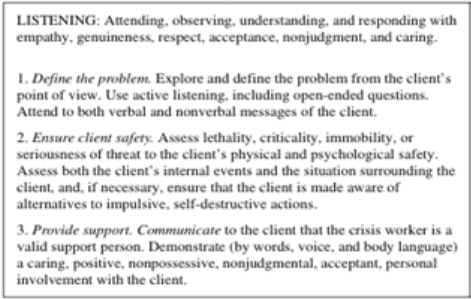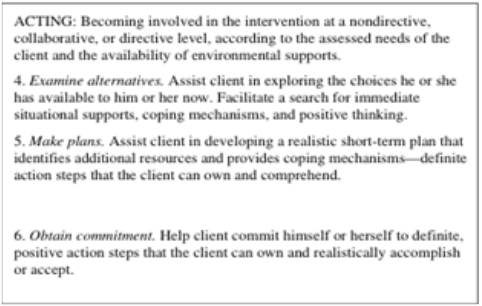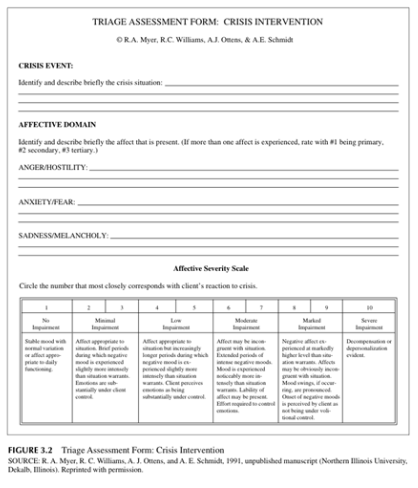Introduction to Crisis Intervention
How do you define a crisis?
- “state of DISORGANIZATION in which people face FRUSTRATION of important LIFE GOALS or PROFOUND DISRUPTION of their life cycles and METHODS OF COPING WITH STRESSORS” (Brammer, 1985, p. 94 as cited in James, 2008, p. 3)
4 Stages of a Crisis:
- Occurrence of a CRITICAL SITUATION: determination is made whether an individual’s normal coping mechanisms would suffice;
- INCREASED TENSION AND DISORGANIZATION SURROUNDING THE EVENT;
- There is a DEMAND for additional resources (e.g counseling) after the event;
- REFERRAL may be required to resolve major personality disorganization.
- Crisis because of the scale
Types of Crises:
- Developmental Crisis:
- events in the normal flow of human growth and evolution, whereby a dramatic change or shift occurs that produces abnormal responses;
- considered a normal part of life; however, EVERY CRISIS IS UNIQUE! Therefore, it must be evaluated and managed depending on the specific situation.
- Mostly individual
- Examples: birth of a child, midlife career change, retirement, illness or disease surrounding the normal aging process
- Situational Crisis:
- emerges with the occurrence of uncommon and extraordinary events that an individual has NO WAY of PREDICTING or CONTROLLING;
- Characteristics of a Situational Crisis: random, sudden, shocking, intense, and often catastrophic;
- Examples: Terrorist attacks like 9/11, Car accidents, Kidnapping, Rape, Loss of Jobs, Sudden illness and Death
- Existential Crisis:
- includes inner conflicts and anxieties that accompany issues of:
- purpose
- responsibility
- independence
- freedom
- Commitment
- Usually concerned with individual only
- Ecosystemic crisis:
- Acts of God
- usually occurs in cases of natural- or human-caused disasters which overwhelm a small or large group of individuals, who through no fault of their own are inundated in the aftermath
- Examples: Hurricanes, floods, tsunamis, earthquakes, volcanic eruptions, tornadoes, blizzards, mud slides, drought, famine, forest or grassland or brush fires, COVID-19 (pandemic)
- May also be biologically-derived (epidemic, oil spill), politically-based (wars, ethnic cleansing), or even in cases of severe economic depression (Great Depression of the Early 20th century)
Why is Crisis Intervention and Management important?
- A crisis may also be defined as a PERCEPTION or EXPERIENCE of an event or situation as an INTOLERABLE DIFFICULTY that EXCEEDS the PERSON’S CURRENT RESOURCES AND COPING MECHANISMS.
- Left unchecked, or if NO RELIEF is found, there is potential for SEVERE AFFECTIVE, BEHAVIORAL, and COGNITIVE malfunctioning.
The Six-Step Model of Crisis Intervention
- Emphasizes IMMEDIATE, ACTIVE, ASSERTIVE, INTENTIONAL, and CONTINUOUS assessment, listening, and acting to help the client regain PRE-CRISIS EQUILIBRIUM.
- Importance of assessment:
- Severity of the crisis;
- Client’s current level of emotional status = emotional mobility/immobility
- Alternatives (to coping)
- Client’s level of lethality (harm to self or others);
- How well crisis worker or interventionist is able to defuse and deescalate problems
3 Skills needed:
The Six-Step Model of Crisis Intervention
- Emphasizes IMMEDIATE, ACTIVE, ASSERTIVE, INTENTIONAL, and CONTINUOUS assessment, listening, and acting to help the client regain PRE-CRISIS EQUILIBRIUM.
- Importance of assessment:
- Severity of the crisis;
- Client’s current level of emotional status = emotional mobility/immobility
- Alternatives (to coping)
- Client’s level of lethality (harm to self or others);
- How well crisis worker or interventionist is able to defuse and deescalate problems
- 3 Skills needed:
- Assessing
- Listening to the client
- Attending (putting focus on the client), observing (everything as a whole), understanding (what they are trying to tell you), and responding with empathy, genuineness, respect, acceptance, nonjudgment, and caring
- Acting what needs to be done


Affective Severity Scale – Frustration of needs is often the precursor of other negative emotions, thoughts, and behaviors that further plunge the client into crisis; prove to be ineffective in helping client regain balance and equilibrium.
- Emotions may be verbally or non-verbally expressed.
- Crisis worker needs to be aware of incongruences between what they are saying, how they are saying it, as well as the client’s body language.

Approach – client seems highly motivated but may be acting MALADAPTIVELY or in a non-goal-directed manner with no specific target or aim
Avoidance – client attempts to flee noxious event by the fastest means possible
Immobility – client is immobile and cannot make important decisions or move forward in the face of crisis
Transgression – awareness that something bad is happening in the PRESENT
Threat – something bad WILL HAPPEN (future)
Loss – something bad already happened (past)
\n